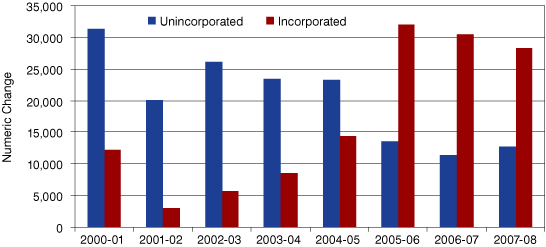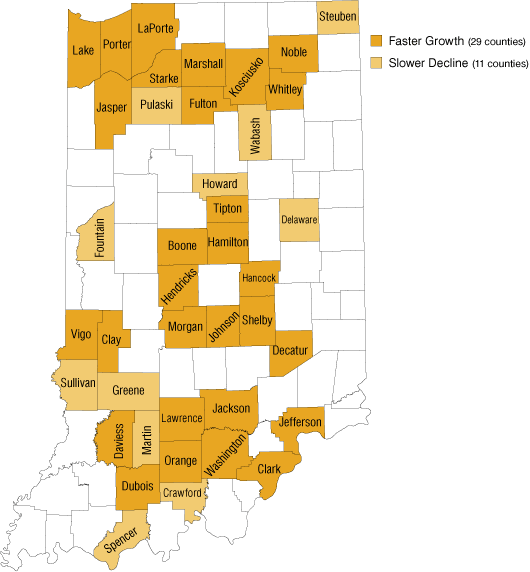Cities and Towns vs. Unincorporated Areas: Latest Growth Trends
Last year, we noted an emerging trend of Indiana's cities and towns outpacing the population growth in unincorporated areas.1 That trend seems to be continuing given the latest sub-county population estimates for 2008. Between 2007 and 2008, incorporated places added 28,245 residents (0.7 percent), while unincorporated areas grew by 12,685 people (0.6 percent).
Figure 1 illustrates the dramatic shift that has occurred since 2005. Between 2000 and 2005, Indiana's unincorporated areas grew by nearly 124,300 people, while incorporated places added approximately 43,800 residents.2 In the three years since 2005, however, unincorporated areas added just 37,560 people, compared to a growth of nearly 90,700 for incorporated places.
Figure 1: Numeric Growth in Indiana's Incorporated Places and Unincorporated Areas, 2000 to 2008

Source: IBRC, using data from the U.S. Census Bureau
As Table 1 shows, the majority of Indiana's population (65 percent) lives in cities and towns, although this is down slightly from 66 percent at the start of the decade.
Table 1: Change in Population for Indiana's Incorporated Places and Unincorporated Areas, 2008
| Unincorporated | Incorporated | Percent of Total Population Living in an Incorporated Place | |||||
| Year | Population | Numeric Change | Percent Change | Population | Numeric Change | Percent Change | |
| 2000 | 2,088,994 | n/a | n/a | 3,991,528 | n/a | n/a | 65.6% |
| 2001 | 2,120,262 | 31,268 | 1.5% | 4,003,680 | 12,152 | 0.3% | 65.4% |
| 2002 | 2,140,347 | 20,085 | 0.9% | 4,006,627 | 2,947 | 0.1% | 65.2% |
| 2003 | 2,166,526 | 26,179 | 1.2% | 4,012,302 | 5,675 | 0.1% | 64.9% |
| 2004 | 2,189,905 | 23,379 | 1.1% | 4,020,896 | 8,594 | 0.2% | 64.7% |
| 2005 | 2,213,263 | 23,358 | 1.1% | 4,035,306 | 14,410 | 0.4% | 64.6% |
| 2006 | 2,226,791 | 13,528 | 0.6% | 4,067,333 | 32,027 | 0.8% | 64.6% |
| 2007 | 2,238,134 | 11,343 | 0.5% | 4,097,728 | 30,395 | 0.7% | 64.7% |
| 2008 | 2,250,819 | 12,685 | 0.6% | 4,125,973 | 28,245 | 0.7% | 64.7% |
Source: IBRC, using data from the U.S. Census Bureau
If we look at the full 2000-2008 time span, the incorporated areas of seven counties grew by more than 10 percent; these include the usual suspects in the Indianapolis suburbs, plus Jasper and Porter counties. Table 2 shows the counties with the fastest growing cities and towns for three different time frames. Hamilton and Hendricks counties top all three of these lists.
Table 2: Counties with the Fastest Growing Incorporated Places
| Percent Change, 2000-08 | Annual Average Percent Change, 2000-2005 | Annual Average Percent Change, 2005-2008 | |||
| County | Value | County | Value | County | Value |
| Hamilton | 43.8 | Hamilton | 5.1 | Hendricks | 4.1 |
| Hendricks | 35.7 | Hendricks | 3.8 | Hamilton | 4.0 |
| Johnson | 24.3 | Johnson | 2.5 | Hancock | 3.2 |
| Hancock | 20.6 | Hancock | 1.9 | Johnson | 3.2 |
| Boone | 16.8 | Boone | 1.7 | Jasper | 2.3 |
| Jasper | 11.4 | Morgan | 1.2 | Boone | 2.3 |
| Porter | 10.2 | Whitley | 1.1 | Clark | 1.7 |
| Morgan | 9.3 | Marshall | 1.0 | Tippecanoe | 1.7 |
| Whitley | 9.0 | Porter | 1.0 | Porter | 1.6 |
| Marshall | 7.1 | Jasper | 0.8 | Shelby | 1.2 |
Source: IBRC, using data from the U.S. Census Bureau
Table 3 shows the counties with the fastest growing unincorporated areas for the same three time frames. Hamilton County again tops these lists. Allen County comes in second for the first two measures, but its rank falls to seventh for the most recent time frame.3
Table 3: Counties with the Fastest Growing Unincorporated Areas
| Percent Change, 2000-2008 |
Annual Average Percent Change, 2000-2005 | Annual Average Percent Change, 2005-2008 | |||
| County | Value | County | Value | County | Value |
| Hamilton | 62.4 | Hamilton | 8.4 | Hamilton | 2.8 |
| Allen | 30.9 | Allen | 4.5 | Boone | 2.3 |
| Hendricks | 27.6 | Hendricks | 4.1 | Hancock | 2.0 |
| Boone | 23.4 | Boone | 2.9 | Monroe | 1.9 |
| Hancock | 22.1 | Hancock | 2.8 | Tippecanoe | 1.8 |
| Clark | 20.1 | Vanderburgh | 2.7 | Clark | 1.7 |
| Tippecanoe | 18.9 | Clark | 2.7 | Allen | 1.6 |
| Monroe | 17.1 | Tippecanoe | 2.4 | Bartholomew | 1.5 |
| Vanderburgh | 16.2 | Elkhart | 2.1 | Warrick | 1.5 |
| Johnson | 14.7 | Monroe | 2.1 | Hendricks | 1.4 |
Source: IBRC, using data from the U.S. Census Bureau
Using the 2005-2008 annual averages, Figure 2 shows that annual average growth in incorporated places outpaced the growth in unincorporated areas for 40 of the 91 counties (Marion County does not have any unincorporated areas so it is excluded from this calculation). Note that 11 of these 40 counties did not experience growth, but rather the decline in incorporated areas was less than the decline in the unincorporated areas.
Figure 2: Counties where Incorporated Places Are Growing Faster than Unincorporated Areas, 2005-2008

Source: IBRC, using data from the U.S. Census Bureau
However, if we compare the annual average percent change for incorporated areas for the two halves of the decade, 71 counties experienced a faster annual average growth rate for their incorporated areas in 2005-2008 as compared to 2000-2005 (see Figure 3).4 Meanwhile, only 22 counties can boast the same for their unincorporated areas.
Figure 3: Counties where Incorporated Places Are Growing Faster in 2005-2008 than in 2000-2005

Source: IBRC, using data from the U.S. Census Bureau
This indicates that although many counties are still seeing more growth in their unincorporated areas when compared to their cities and towns, most counties are seeing a turn-around in incorporated growth from earlier in the decade. Even as the recession has the potential to cause Indiana's overall population growth to slow down temporarily,5 the drop in new home construction (a major source of growth for the unincorporated areas), may entice even more Hoosiers to call the state's cities and towns home in the coming year.
Notes
- Rachel Justis, "Changing Trends: Cities and Towns Gaining Population," InContext, September-October 2008, https://www.incontext.indiana.edu/2008/sept-oct/4.asp.
- The estimates base was used for all calculations, which means that these estimates are adjusted for boundary changes, such as annexations. Therefore, the resulting numbers reflect actual demographic changes and not changes due to shifting boundaries. For more about the estimates base, visit http://www.stats.indiana.edu/about/estimatesbase.asp.
- It is perhaps worth noting that Marshall County in Table 2 has the distinction of being the only county in Table 2 and Table 3 that is not part of a metropolitan statistical area.
- Twenty-eight of the 71 experienced a smaller decline in 2005-2008 than in 2000-2005.
- Matt Kinghorn, "Population and Employment Change in Indiana," InContext, July-August 2009, https://www.incontext.indiana.edu/2009/jul-aug/article1.asp.
Rachel Justis
Geodemographic Analyst, Indiana Business Research Center, Indiana University's Kelley School of Business
